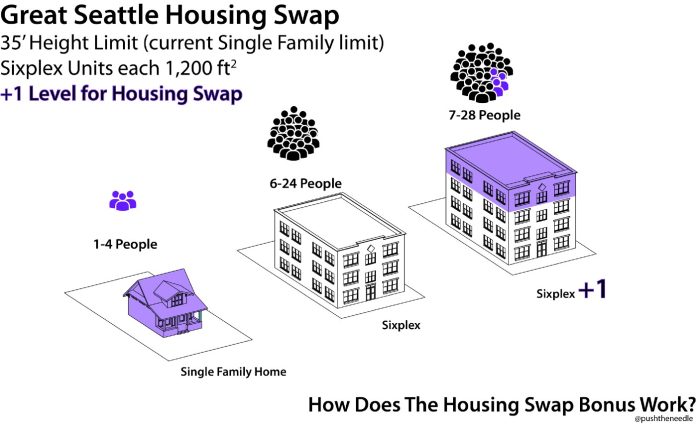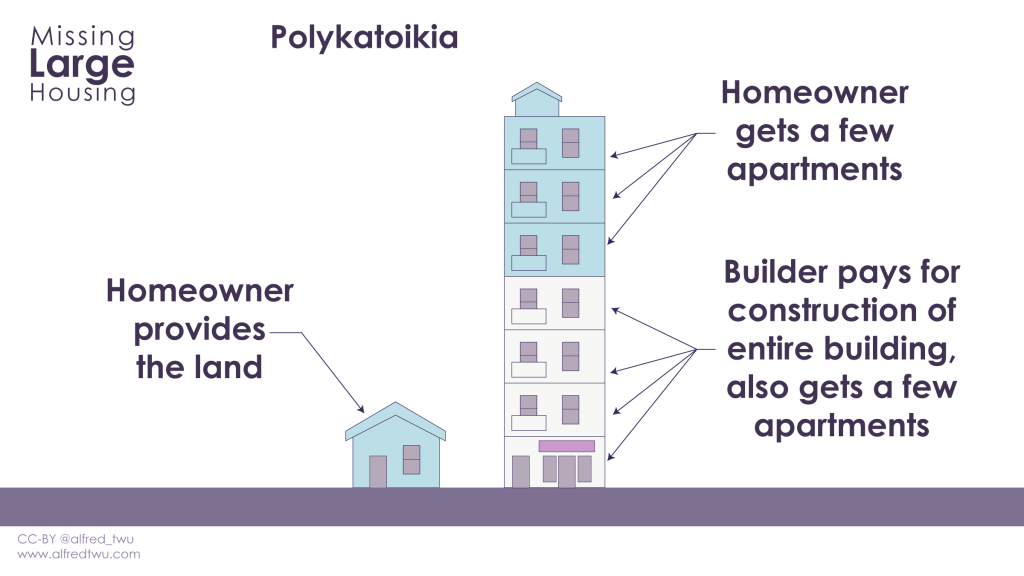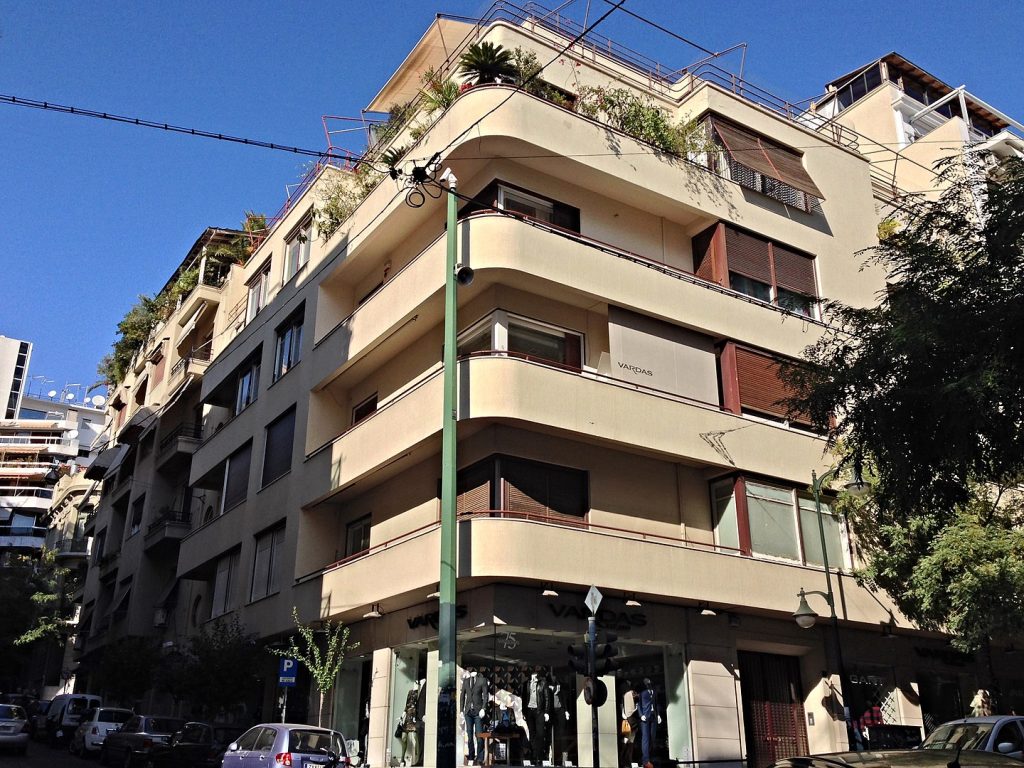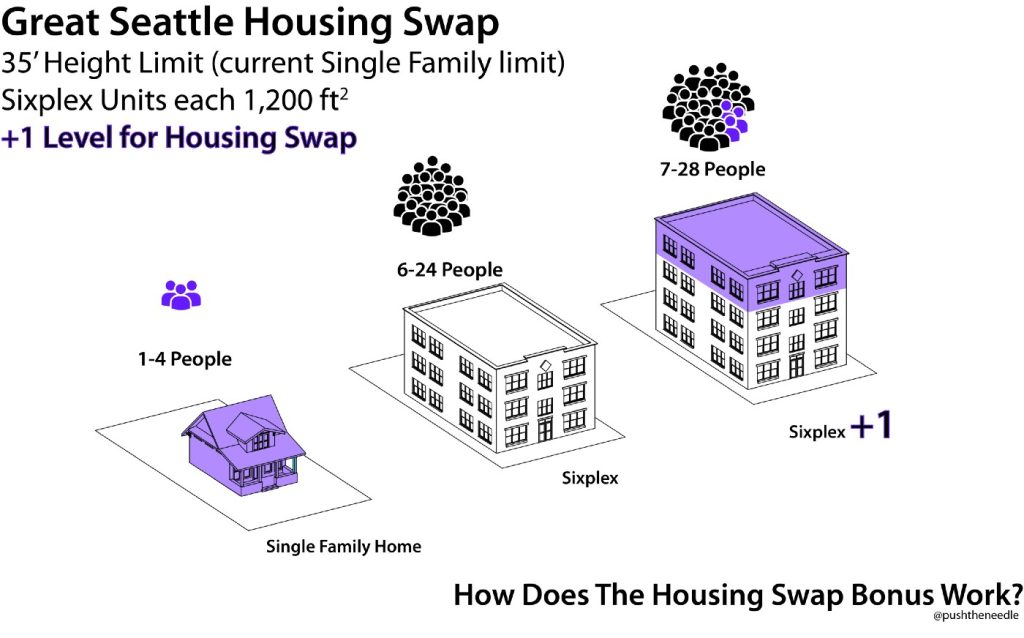
Imagine if you could partner with a developer to build a multiplex or rowhouse on your property, and, in exchange for the land, you were gifted a home in the new development? This is the concept for the “Great Seattle Housing Swap,” an idea that will leverage our residential land to create housing growth in our neighborhoods, allow existing residents to age in place, and lower the financial burdens of displacement and new housing costs.
This isn’t a new idea.

Athens, Greece used to be a city of lowrise, single-story residences in their urban core until the 1920s when they realized their city population was not going to stop growing. People were land rich and house poor. So, what did they do? They partnered homeowners with developers and created one of the most interesting housing swap concepts ever seen. A developer would replace their house with a stacked flat, and give them a home in the new building in addition to some apartments to rent as a tradeoff. The term is Polykatoikia and it is fantastic.

Seattle is in a similar situation in the 2020s, where housing prices have exploded so much people have nowhere to go and only the wealthy are able to buy in. Like Athens, we need to recognize our population is still going to grow and unless we leverage the vast majority of land that mandates one housing type, we will only make it more impossible for anyone to live here.
What should Seattle do to replicate this concept?
1. Legalize it
For starters, the city must upzone every neighborhood so rowhouses or a sixplex are legal to build by-right everywhere. This will allow the city to adequately handle as much as three million people for population growth, instead of grappling with a housing crisis when we barely have more people than El Paso.
What holds us back is single-family zoning dominating 30 square miles of our 40 square miles of land we can build housing on. This means 75% of the land is restricted against housing growth. This must change first.
Allowing a sixplex would not change the maximum height allowed in neighborhoods, which is currently capped at 35 feet (or, three stories). The other change should be growing lot coverage going from 35% to 50%. This allows a 2,500 square foot footprint on a standard sized lot, allowing both units split down the middle to be comfortably sized. There are other changes we need to make such as front setbacks limited to three feet maximum, and side setbacks reduced to two feet minimum so we have the widths to create nice sized units and the requirement to push buildings to the street so back yard gardens can be shared by residents.
2. Incentivize it
In addition to sixplexes by-right citywide, we should incentivize the housing swap concept further. Any developer building a residence for the existing homeowner should automatically get a fourth level bonus. That way we can build the six homes below, and keep that family on their property in their neighborhood as well. This way a developer can look at only the cost of construction to add another unit, and not worry about dividing other costly endeavors, like utilities and land acquisition, with the seventh family. If neither side wishes for this agreement, that’s okay too; let them still build a three-story sixplex on-site and move on. The owner can cash out on the land sale, or decide they want to stay and swap the land for a single-level unit on whichever level they prefer.
3. Streamline it
The city should work with architects and designers to establish a series of pre-designed plans with flexible changes that are already approved by the building department. This will speed up the time to begin construction and recreate the catalog of kit housing that built all these Craftsman bungalows around the city. (I swear to god, if we have to listen to a group of architects bicker about brick style and color on these modest projects, I will scream.) Let’s skip design review all together and just push these projects to the building department to obtain construction permits. We don’t need long-winded meetings twice a month to talk about a multiplex on a small lot. Save that for towers and public projects. Increase the threshold for design review to be buildings greater than 10 stories so we can stop letting neighbors fight and bottleneck these types of modest housing projects typical of liberal Seattle hypocrites.
4. End parking minimums
This one is easy. We don’t have parking minimums in Seattle’s urban centers and much of urban villages, which take up 18% of our city’s land (including our densest neighborhoods of Downtown, South Lake Union, First Hill, and Capitol Hill). If it’s good enough for them, it is good enough citywide. Let a developer decide if it’s worth building. Chances are it won’t be since below-grade parking is expensive and ruins space.
5. Allow commercial spaces on corners
Some lots are special. Portland is famous for having shorter blocks to create more corners, since corners are valuable to urban economies. We should allow corner lots to feature retail spaces and limit them to the first floor. This means shops no larger than 2,500 square feet will be able to fit in the space, which is good for small business and rent. Who wouldn’t want to live in the same building as a coffee shop, bakery, bookstore, or general store? The Great Seattle Housing Swap will finally create blocks that feature four floors and cornerstores.
The developer is not a supervillain
When John Wallingford showed up in Seattle, he build a ton of housing for a neighborhood that thanked him by naming the neighborhood after him and electing him twice to Seattle City Council. Ironically, residents there today despise developers and love what developer John Wallingford built them 100 years ago. Perhaps with partnerships like these, we can not only build four floors and cornerstores, but we can also stop scapegoating developers and bashing them for doing what they’ve always done here and elsewhere: build housing.
A lot of people bought Seattle’s homes when they were plentiful and affordable. This is who this is for. Rather than being locked in to their house with nowhere to go, seeing prices soaring around the city and entire region, here is a chance for individuals to add housing on-site without going anywhere. Who knows, maybe when enough people sign up for this program, we will have proud generations converting spaces to live in commune with their grandkids the way the Greeks did 100 years ago.
This article is a cross-post from Ryan DiRaimo’s personal blog.

Ryan DiRaimo
Ryan DiRaimo is a resident of the Aurora Licton-Springs Urban Village and Northwest Design Review Board member. He works in architecture and seeks to leave a positive urban impact on Seattle and the surrounding metro. He advocates for more housing, safer streets, and mass transit infrastructure and hopes to see a city someday that is less reliant on the car.


